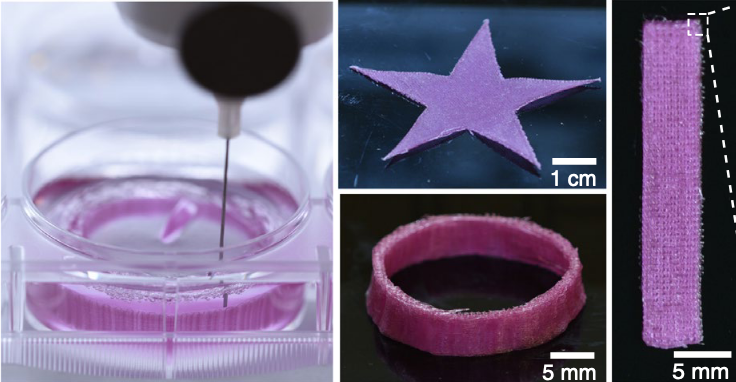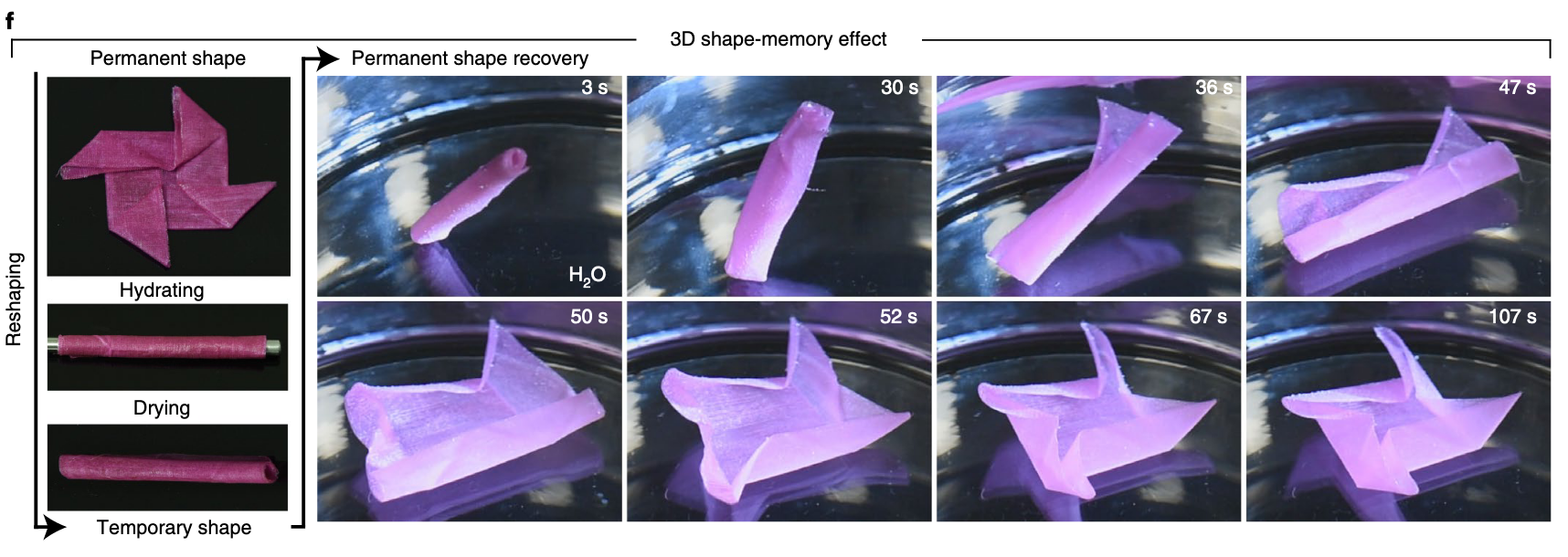Researchers at Harvard University‘s John A. Paulson School of Engineering and Applied Sciences (SEAS) created a new material from keratin that can be 3D printed into complex shapes and pre-programmed with reversible shape memory. With potential applications in bioengineering and smart textiles, the new development is ideal for engineering strong and stiff water-triggered shape-memory devices with tensile strength and complex geometrical transformations.
The new study is the latest from SEAS researchers and proposes a bioinspired design for the fabrication of a biocompatible and hierarchically structured shape-memory material 3D printed from waste keratin. Published in the journal Nature Materials, the report, A bioinspired and hierarchically structured shape-memory material, confirms the ability of the 3D printed object to recover its original shape.
Furthermore, the processability of the new material through additive manufacturing platforms allows for the production of complex architectures with structural features in the micrometer range, which makes the material suitable for a vast range of bioengineering applications.
“With this project, we have shown that not only can we recycle wool but we can build things out of the recycled wool that have never been imagined before,” said Kevin Kit Parker, the Tarr Family Professor of Bioengineering and Applied Physics at SEAS and senior author of the paper. “The implications for the sustainability of natural resources are clear. With recycled keratin protein, we can do just as much, or more, than what has been done by shearing animals to date and, in doing so, reduce the environmental impact of the textile and fashion industry.”
Keratin is a versatile bioactive polymer abundantly distributed in nature and has turned out to be very attractive for many advanced applications, ranging from agriculture to biomedical engineering. It is the major component of the epidermis found in hair, nail, feather, wool, hooves, scales, and horn, of higher vertebrates such as mammals, birds, and reptiles. It is also a major constituent of human epithelial tissues.
The key to keratin’s inherent shape-changing abilities is its hierarchical structure, said Luca Cera, a postdoctoral fellow at SEAS and first author of the paper. In the study, a single chain of keratin is arranged into a spring-like structure known as an alpha-helix. Two of these chains twist together to form a structure known as a coiled-coil. Many of these coiled coils are assembled into protofilaments and eventually large fibers. Moreover, Cera suggested that the organization of the alpha helix and the connective chemical bonds give the material both strength and shape memory.
According to SEAS, when a fiber is stretched or exposed to a particular stimulus, the spring-like structures uncoil, and the bonds realign to form stable beta-sheets. The fiber remains in that position until it is triggered to coil back into its original shape. To demonstrate this process, the researchers used keratin as ink to 3D print sheets in a variety of shapes, programming the material’s permanent shape — the shape it will always return to when triggered — using a solution of hydrogen peroxide and monosodium phosphate. Once the memory was set, the sheet could be re-programmed and molded into new shapes.

3D printing process using extracted keratin as ink to create keratin architectures such as flat star, ring and flat strip. (Image courtesy of Harvard University’s John A. Paulson School of Engineering and Applied Sciences)
The 3D printed objects have moisture-responsive shape-memory properties. As part of the study and to illustrate the efficiency of the shape-memory mechanism in operating rather sophisticated geometrical transformations, the researchers folded one keratin sheet into a complex origami star as its permanent shape. The study suggested that, when hydrated, the 3D printed origami model was malleable and could be unfolded and arbitrarily reshaped as a rolled tube. Once dried, the square sheet lost its malleability and was locked in its new temporary shape. In order to reverse the process, researchers simply placed the tube back in the water to regain the original origami shape.
In the study, the investigators first extracted keratin from leftover Angora wool used in textile manufacturing. Then they used Cellink’s BIO X platform to print the material. To help visualize the object structure during printing, researchers added Rhodamin B (a chemical compound and fluoresce dye) to the keratin dope as a magenta-colored tracer. After 3D printing, a star-shaped origami model was fabricated by manually folding the 3D printed squared sheet and permanently fixing its new configuration in a hydrogen peroxide-based solution. This two-step fabrication process allowed researchers to tailor 3D printed basic geometries to achieve permanent architectures with a higher degree of complexity.

Post-3D printing process to tailor the shape of basic 3D printed structures into a star-shaped origami model from a flat square. (Image courtesy of Harvard University’s John A. Paulson School of Engineering and Applied Sciences)
Based on the new study, the scientists were able to determine that the unique combination of high mechanical performances and shape-memory effect makes the engineered material suitable for designing actuators that could be used in the smart textile industry. The biocompatibility and body affinity of the material can be leveraged to replace oil-based polymers used for engineering strain-responsive and body-adaptable apparel.
In the last years, several companies have attempted to introduce technology in clothing textiles by creating smart clothing as part of new potential business models for the next decade. For example, Under Armour developed a range of clothes that absorb heat from the human body and reflect it back onto the wearer’s skin as Far Infrared Light, which is safe energy that is said to encourage better muscle recovery and enhance relaxation; while Georgia Tech researchers created energy-harvesting yarns that can be woven into washable textiles.
“Whether you are using fibers like this to make brassieres whose cup size and shape can be customized every day, or you are trying to make actuating textiles for medical therapeutics, the possibilities of Luca’s work are broad and exciting,” said Parker. “We are continuing to reimagine textiles by using biological molecules as engineering substrates like they have never been used before.”

The water-triggered shape-memory effect in 3D architectures, which is illustrated with a star-shaped origami model. (Image courtesy of Harvard University’s John A. Paulson School of Engineering and Applied Sciences)
The research could also help address the broader effort of reducing waste in the fashion industry – one of the biggest polluters on the planet – which already has brands like Stella McCarthy and even fashion giant Zara reimagining how the industry uses materials, including wool, working towards a more sustainable fashion movement. For example, keratin waste is considered an environmental pollutant, as it is usually dumped, buried, or incinerated after it is discarded from poultry farms, slaughterhouses, and leather industries, which is why new materials that use keratin waste could offer a sustainable solution to a devastatingly physically and biologically contaminated Earth.
The progress of new materials for the 3D printing industry has increased in the last five years, especially with the upsurge in the demand for shape memory devices in the fields of civil engineering, aerospace, wearable technologies, and medical devices. The biocompatibility and processability of this particular new material through 3D printing technology shows a lot of promise, according to the authors, making the material ideal for the production of complex architectures with micrometer structural features that could work very well in bioengineered devices.
Subscribe to Our Email Newsletter
Stay up-to-date on all the latest news from the 3D printing industry and receive information and offers from third party vendors.
You May Also Like
3D Printing Unpeeled: New Arkema Material for HP, Saddle and Macro MEMS
A new Arkema material for MJF is said to reduce costs per part by up to 25% and have an 85% reusability ratio. HP 3D HR PA 12 S has been...
3D Printing News Briefs, January 20, 2024: FDM, LPBF, Underwater 3D Printer, Racing, & More
We’re starting off with a process certification in today’s 3D Printing News Briefs, and then moving on to research about solute trapping, laser powder bed fusion, and then moving on...
3D Printing Webinar and Event Roundup: December 3, 2023
We’ve got plenty of events and webinars coming up for you this week! Quickparts is having a Manufacturing Roadshow, America Makes is holding a Member Town Hall, Stratafest makes two...
Formnext 2023 Day Three: Slam Dunk
I’m high—high on trade show. I’ve met numerous new faces and reconnected with old friends, creating an absolutely wonderful atmosphere. The excitement is palpable over several emerging developments. The high...































